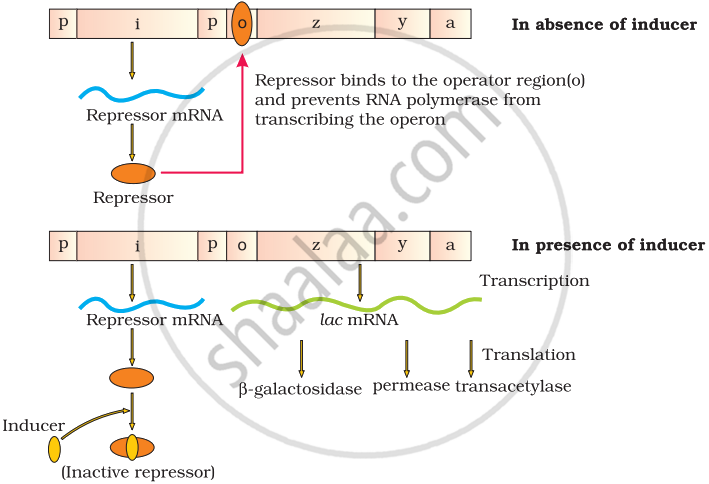Advertisements
Advertisements
प्रश्न
In the medium where E. coli was growing, lactose was added, which induced the lac operon. Then, why does lac operon shut down some time after addition of lactose in the medium?
उत्तर
Operon Concept The bacterium E. coli found in the human intestine generally obtains energy from the catabolism of lactose. Jacob and Monod (1961) discovered that a group of three genes in its DNA is related to the synthesis of three enzymes that catabolize lactose. These genes become active when there is lactose in the nutrient medium. They remain inactive in the absence of lactose in the nutrient medium. Jacob and Monod introduced the operon concept for the regulation of the activity of this gene.
According to the operon concept, gene activity regulation occurs by induction or repression at the transcription level. The enzymes that catabolize lactose are beta-galactosidase, galactose permease and thiogalactosidase transacetylase. Their structural genes are represented by cistron-z, cistron-y and cistron-a respectively. These are located close to each other. There is mutual coordination between them.
Three genes control them, these are called regulator gene, promoter gene and operator gene. The genes coding for enzymes in a metabolic system are generally located on the chromosome in the form of a cluster. These form a functional complex. This entire system is called lac operon. In this, structural genes, promoter genes, operator gene and regulatory genes etc. are found.
lac operon = regulatory gene + promoter gene + operator gene + structural gene Function of lac operon
- In the absence of Lactose – In the absence of lactose inducer, the regulatory gene produces a lac inhibitor or repressor protein. It binds to the operator gene and prevents its transcription. As a result, the structural genes cannot synthesize m-RNA and protein synthesis stops. This is an example of repression.

- In the presence of Lactose - In the presence of Lactose inducer in the medium, the promoter enters the cell and binds with the repressor produced from the regulator gene and forms a complex compound. Due to this the repressor cannot bind with the operator and the operator remains free. This induces RNA-polymerase to bind with the start site of the promoter gene as a result of which transcription of polycistronic lac m-RNA takes place. It codes for all the three enzymes required for lactose catabolism. This process is called an enzyme catalyst. This is an example of a catalyst or induction. In this lactose acts as a catalyst.
- Co-repressor - Sometimes the structure of the inhibitor or repressor changes when it binds to the metabolism (lactose). It binds to the operator and stops its transcription. In this, the metabolism (lactose) is called a co-repressor because it activates the repressor to inactivate the operator site.
संबंधित प्रश्न
Sketch and label ‘ultrastructure of mitochondrion’.
In lac operon, lactose acts as:
Give diagrammatic representation of Lac-operon in the presence of inducer.
Identify the event that would occur in 'lac operon' of E. coli when the growth medium has high concentration of lactose.
In E.coli, the lac operon gets switched on when ______.
Select the two correct statements out of the four (A-D) given below about lac operon.
- Glucose or galactose may bind with the repressor and inactivate it.
- In the absence of lactose, the repressor binds with the operator region.
- The z-gene codes for permease.
- This was elucidated by Francois Jacob and Jacque Mono.
E. coli cells with a mutated Z gene of the lac operon cannot grow in medium containing only lactose as the source of energy because ______.
Select the correct pair.
What is the role of a repressor gene?
Which gene acts as a regulatory gene in lac operon?
